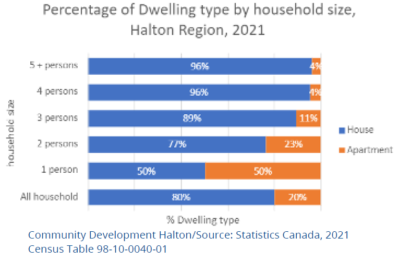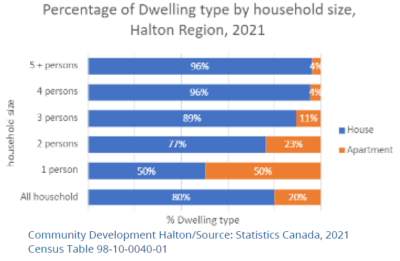 By Staff
By Staff
August 3rd, 2022
BURLINGTON, ON
Community Development Haltom is a non-profit organization that focuses on community wide issues within the Region of HAlton.
They provide data that aids decision makers at the Regional and municipal level.
The number of people living in a household, i.e., household size, can have various social and economic implications. For example, smaller households will increase the demand for more housing, most likely in the form of apartments or condominiums, and more household items like furniture and appliances. Financially, smaller households can have fewer wage earners and possibly lower household incomes. The opposite is true for larger households. In addition, members in larger households can enjoy some household economies of scale in the consumption of goods and services.
For decades, households were getting smaller due to lower fertility rates, higher separation and divorce rates, and more people remaining single.
However, there are signs that the decline is slowing or even levelling off.

The growth has taken place in Milton – they had greenfield land left. Now that the housing growth will be in high rise – there may be changes in where the growth happens. Burlington is going to create three new communities in the next two decades around the GO stations.
In Halton municipalities, with growth and demographic changes, household size trends might vary from the provincial or national patterns. The average household size for Halton Hill and Oakville has been at 2.9 for the last two decades. Burlington’s household size dropped in 2006 and levelled off at 2.5. Milton’s household size rose from 2.9 in 2006 to 3.3 in 2021.
The share of households by size varies among the local municipalities. In 2021, Burlington had the highest proportion of 1- person and 2-person households and the lowest proportion in the other categories.
Milton had the highest proportion of 4- and 5+ person households accounting for over 45% of all households within the municipality.

Large families were in houses – as high rise apartments appear – where will the large families live?
The following chart shows the percentage of the population in various sizes of household. In all municipalities, less than 10% of the population live in

This data is what is going to have to be fully understood – what is it telling us?
1- person households. Over one quarter (27%) of Burlington’s residents live in 2-person households. In Milton, only 4% of Milton’s population live alone. About one-third (33%) live in 4 person households compared to 16% in Burlington. Milton also has the highest share of the population living in 5+ households.

This data cannot remain the same – there aren’t going to be any new single family dwellings in Oakville and Burlington.
About 80% of Halton’s households lived in houses as compared to Ontario’s 68% and Canada’s 64% respectively. These percentages change with the size of households reflecting the affordability and availability of housing. For example, among the 1-person households, over 60% lived in houses in Milton and Halton Hills, 50% in Oakville and only 40% in Burlington (60% in apartments).
Community Development Halton/Source: Statistics Canada, 2021 Census Table 98-10-0040-01




















Hi Penny.
Just checked the Real estate listings for Burlington. 2 Bedroom condo’s are going for $600,000 to $650,000 range. If you shop around you can do better. What I did notice is that there not a whole lot of listings. Clearly a shortage, created buy our Nimby Mayor and the thousands of Nimby’s in Burlington.
From what I understand she has delayed roughly 57 Buildings,by sending them to the OLT. after rejected their applications. This would include the 7 Buildings the City lost the appeals at the OLT. These total in the thousands of units that construction has been delayed. Penny your a smart cookie (Can I still say stuff like that?)
Is what I’m saying the truth?
Come on Alfred! Even if all 57 buildings were magically approved tomorrow it wouldn’t materially improve housing affordability in Burlington. To dismiss this as “Nimbyism” is both disingenuous and unfair to residents who raise legitimate concerns around excessive height and density issues that impact quality of life.
The fact is that the quality of housing stock being developed in Burlington is not what most families want or expect. The development industry is solely interested in profits, and produce housing of a type and quality that yields maximum profit. It is out of sync with consumer wants. You can’t expect families to raise kids in a 600 sq. ft., one bedroom condo. Families with kids are more interested in parks and green space, not whether the condo has a jacuzzi or concierge service.
If Doug Ford wants to do something useful to improve affordability he could offer tax incentives to first time buyers to relocate to smaller, outlying urban centres where housing is cheaper. Many of these communities are dying, and would benefit from an influx of younger residents. We don’t need to shoe-horn millions of people into the GTA creating the kind of intensification and environmental degradation visible in places like California. The government should also investigate long-term, fixed rate mortgages the kind which allowed veterans to purchase homes after WWII. The focus should shift to encouraging small home construction or mid-level, multi-unit developments, not more amorphous high-rises lacking in both functionality or aesthetic appeal.
The other glaring reality is that there are economic forces at play right now that will have a profound and lasting impact on the housing market going forward. Interest rates are rising. A recession is looming. The price of homes is already starting to decline, down 47% in Toronto from last year. Let’s see how many luxury condos ADI and Carriage Gate can sell when that $1.5 million unit comes to market and is suddenly only worth a fraction of its former listing price.
Alfred.
Not many listing? Why’s that? Have you heard Prime rate went up another 75 basis points causing mortgage rates to increase, causing many potential purchasers to no longer have mortgage eligibility. Nothing to do with nimbyism or the Mayor.
The Mayor did not delay those projects. The Mayor and Council have been trying to defend the City’s (by that I mean the residents of the city) desire not to have a downtown of ultra high rise condo towers, which will have no units affordable to those on incomes of less than $100,000.
A condo costing $600,000 requires a down payment of 10% ($60,000). The $540,000 principle generates a bi-weekly payment of $1,700 for a 5 year mortgage. To qualify for that mortgage an income of $147,000.
The average annual income in the GTA is $46,000. So none of those condo towers will provide any units that can be afforded by the average person.
Stop your misinformation
If developers have their way we will be living in a 794 square foot unit that will provide 2 or 3 bedrooms at a price of over $1,200.00 per square foot.